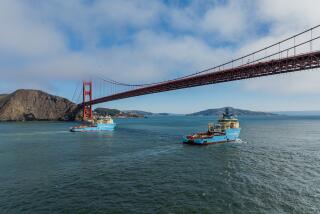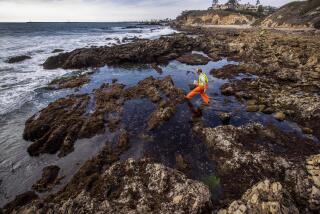Exxon Must Finish Alaska Oil Cleanup
- Share via
ANCHORAGE, Alaska — Exxon was ordered by the Coast Guard Tuesday night to return to the oily shores of Alaska and complete its unfinished oil spill cleanup this spring and summer.
Exxon cleanup crews must be back on the beaches by May 1, Coast Guard Rear Adm. David Ciancaglini said at a meeting of Exxon and government agencies involved in the nation’s largest oil spill.
“We’ve always said we’re going to do whatever the Coast Guard asks,” said Otto Harrison, Exxon general manager for the cleanup.
However, Exxon won’t return with last summer’s army of 12,000 workers and barges mounted with high-pressure hot-water hoses, Harrison and Ciancaglini said.
The admiral said he expects a smaller force of Exxon workers to attack remaining oil with shovels, tilling, excavation, booms, oil-eating bacteria and whatever else will work on the crude left in the environment.
The announcement was greeted with cautious optimism by Alaska, which has long clamored for Exxon to return to the job, but environmental officials were uncertain just how much cleaning Exxon was going to do.
“This will not be just an exercise,” Ciancaglini insisted. “There’s no question about it. There will be a cleanup.”
The 987-foot Exxon Valdez crashed into Bligh Reef a few minutes after midnight last March 24, ripping itself open on the rocks and spewing nearly 11 million gallons of crude oil into Prince William Sound, killing up to 270,000 sea birds and thousands of otters, causing eagles to abandon nests, ruining fishing and leaving native villagers with deep uncertainty about their survival off the sea.
By the time the oil industry mounted any meaningful response to the spill, winds and waves had carried the crude far and wide. Exxon eventually mounted a massive cleanup, spending an estimated $2 billion, but the job was incomplete when Exxon called off its crews for the winter on Sept. 15.
In the stormy winter months since then, Mother Nature has scoured some exposed beaches, but oil lingers on unexposed shores and below the surface, and Ciancaglini said Exxon’s job will be to remove as much of it as possible.
More to Read
Sign up for Essential California
The most important California stories and recommendations in your inbox every morning.
You may occasionally receive promotional content from the Los Angeles Times.










